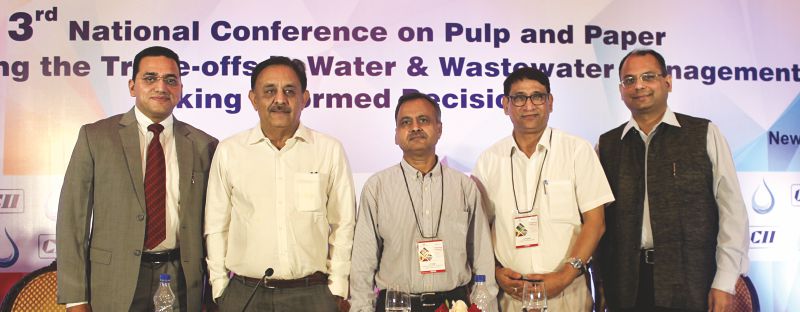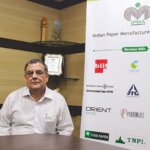CII-Triveni Water Institute in association with Indian Paper Manufacturers Association (IPMA) organized the 3rd National Conference on Pulp & Paper in New Delhi on June 29, 2018 on water and wastewater management with a focus on adoption of new and emerging technology.

Understanding the Trade-offs in Water & Wastewater Management for Taking Informed Decisions was the theme of the 3rd National Conference by CII-TWI in partnership with IPMA. The theme was well-timed and well-received by the Indian pulp and paper industry as the water related crises are now routine in one or other part of the country. The conference is third in series and is gaining momentum with every edition as the subject is too pressing to be ignored now.
The crucial point that emerged out of the conference was the need to understand the significant trade-offs, viz. environmental and economic, in water and wastewater management for taking informed decisions. The industry representatives and water experts all in unison confirmed the present and imminent water crises and exhorted the water-intensive Industry to take the matter seriously for diffusing the lurking crises. Topics such as how to reduce the wastewater volumes with less salt loads; optimization of water use through water pinch analysis; and adoption of new and emerging technology in water and wastewater management were discussed at length by various experts. One of the important discussions was how the industry can use decision support systems (DSSs) for taking informed decisions on water related issues.
.
Need to Step up Efforts
Highlighting the major water scarcity events in various parts of the country, Mr. Sanjay Singh, Divisional Chief Executive, ITC-PSPD said, “In the next few years, water is going to become a reason for major crises. Of course, we are taking steps for water conservation, but now it is time to step up our effort regarding conserving, reusing, and recycling water. One of the purposes of this conference is to create awareness in the pulp and paper industry about the importance of securing water for running the industry.
“There are various case studies that have mentioned the great efforts of the Indian paper industry in best practices and reduction of water consumption. Water is the primary resource for the paper industry and in order to ensure its availability, consolidated efforts need to be made by following the principle of three Rs – Reduce, Reuse, and Recycle. The pulp and paper industry should work with the mission mode approach for the effective and judicious way of water consumption and follow the national charter drafted by CPCB, which focuses on the participatory approach and technology upgradation. When selecting best management practices, consideration should be given to the economic and technological feasibility in order to provide the greatest conservation benefits for the implementation.”
Mr. Singh also underlined the salience of appropriate water pricing mechanism and urged the industry to closely work with policy makers to consider the efforts of the industry while fixing water charges. He said, “The need for introducing an appropriate water pricing mechanism for incentivization of water conservation measures was necessary. In Tamil Nadu, the government has increased the water charges for the industries – from 50 Paisa to Rs. 20/m cube, which is a steep jump. The sad part of it is that the Govt. will be charging the paper industry on the contract demand basis. The paper industry has reduced a significant amount of water consumption by investing more in technologies. The government has not paid any recognition for this achievement. We need to work with the policymakers to make them realize that they must encourage the industry to reduce the water, but also give them the necessary incentives. The cost impact of this is going to be huge on the industry, and of course, the Tamil Nadu based industries are going to face the brunt of it first. Other state governments may start implementing similar acts. We need to work with the government on this aspect for the sustainability of the paper industry.”
Talking about the topics of the current edition, he said, “We need to focus on evaluating the trade-offs in water management, giving special attention to the regulations and reforms that specify and control the volume and extent of wastewater generated by the pulp and paper industry. There are new developments defined both in terms of stricter enforcement and tougher standards in water use, wastewater generation, and concentration of salts.
“As these possible trade-offs of wastewater generation and salt loads vary significantly between sites and regions, it is necessary to carefully monitor and manage wastewater, its quality, sources and use for location-specific risk assessment and reduction. We also have a presentation on certain proposed pilot plant studies. It is a UNIDO implemented project which focuses on development and adoption of appropriate technologies for enhancing the pulp and paper sector. This is with the support of the DIPP, the Government of India. The project was implemented in a close cooperation with CPPRI and technical support of international experts.”
“At present, the situation in the country is becoming alarming because of uncertainties caused by the external factors like weather. These factors are making it complex for the industry to plan things judiciously. Luckily, we have CII water institute. It will be interesting for us to learn from them about what all can be done for the pulp and paper industry to take care of the future water demand. They have got certain tools and techniques, and I am very happy that ITC is engaging them for a study in our unit in Tamil Nadu,” he said.
.
More than Scarcity, It’s a Problem of Buffers
Dr. Kapil K Narula, Executive Director & CEO, CII-Triveni Water Institute during his speech underscored a number of issues related to water challenges and suggested ways to overcome them. “The water is getting scarce and priced. The industry needs to be pre-prepared to handle the challenges which are going to come in the future with respect to water shortage. About 70-80 percent of the pulp and paper plants are lying in high water stress zone. More than 60 percent of the plants are in low-moderate groundwater availability areas,” he informed.
He further said, “Another indicator is the spreading pollution in the groundwater. The pulp and paper industry is not responsible for this pollution but at the same time it will always be at the receiving end, given the resources are getting polluted; therefore, the net availability of fresh water comes down further. As the resources shrink and become scarcer, the pricing issues will exaggerate and come up more on the surface.
“A lot of international pulp and paper plants have been facing this as a challenge and have been bringing down the specific effluent volume. Putting it into an example, Germany succeeded in bringing down the effluent volume from 1970 to 2012. Drastic reductions have been achieved. Again, Germany went through a whole surface water problem, a magnitude of issues which India is also facing at the same time now. If I look at the grade specific effluent volume in the German paper industry, there have been reductions achieved for the specialty papers.”
Mr. Narula said that the limitation to the industry’s growth and expansion is not about the problem of scarcity rather it is not coming out of the problem of sudden pollution or droughts. He added, “It is actually a problem of buffers. Do we have any idea of the situation or condition of buffers that guard our operations? The issue is to have our buffers in place, which actually will come to our rescue when we face the problem of scarcity and stress. This is where we need to have a clear-cut idea of putting these buffers in place.
“There are different types of buffers. The municipal interface is a kind of buffer. The moment you start looking at various kinds of buffers, you create new storages and strategic ground buffers. You can look at the treated wastewater reuse and the process integration is a very important thing that needs to be done. There is not a single unit in the country that has applied pinch technology for processes in an integrated manner. Similarly, municipal interface, if close to the coast then desalination, and water imports from different watersheds. It is really important to understand the plant you have in the context of where it sits in the watersheds; the condition of the watershed in order to generate your buffers.”
“We have water audits, which play a very important role certainly, and are at the same time really important to move towards process integration, which will only come when we will apply optimization techniques such as water pinch, and therefore, we use recycle and reuse systems that can maximize without putting too much on the cost size that can maximize your recycling options, and therefore, acts as a buffer against the problems that we face,” he said.
He added, “I would mention the new tool that we have developed, known as WatSmart, whose whole objective is to asses every plant with regard to how good it is in generating a buffer for operational continuities. The buffer could be inside the fence in your own treatment systems. It could also be a combination of what you do outside the fence. A buffer gives you ratings on how prone are you today in terms of operational continuities. We are putting global indicators into the tool.”
.
Adoption of Appropriate Water Management Tools and Practices
Mr. B.P. Thapliyal, Director, CPPRI, Saharanpur said that conference is a timely initiative by CII and CII Triveni Water Institute to deliberate on the priority agenda of water management, specifically in the pulp and paper industry, which is generally perceived as one of the water-intensive industries and is seriously facing the water crises. He added, “The water scarcity has also hampered the growth of the industry. The industry however is looking forward to adopting appropriate water management tools and practices to ensure its sustainability. In this regard, CII has been actively pursuing the efforts to address the issues by developing water management tools and practices, and integrate these tools with trade-off factors. The issue is more important as mills need appropriate strategies and indigenous technologies to achieve zero or near zero liquid discharge. This needs a right amalgamation of technologies and the management tools to help the industry take the informed decisions.”
Speaking on various tools for the effective water management, Mr. Thapliyal said, “The deliberation on water pinch during this conference, which is a tool to provide a logical and systematic framework for best allocation of resources, will also be extremely helpful to industry to find the solutions. Water pinch is a tool that can be used as a guide for water and wastewater management decisions. Therefore, it can be huge help in improving the efficiency of processes. It can be used for the initial design of the processes as well as to guide the process modification in the plant. The procedure enables the minimum amount of water to be determined by considering the introduction of recycled loops and reuse of the cascades within the system.”
He further elaborated, “The issue has become more important in the context of Clean Ganga Mission, which states that no untreated sewage or effluent will be allowed to be discharged on the river Ganga by 2020. In this regard, advanced technologies such as membrane filtration, ultrafiltration, reverse osmosis, etc. are the technologies suitable for the recovery of water from wastewater. But, the techno-economic feasibility of such technologies is yet to be established on the commercial scale. Further, these technologies are energy intensive which itself has a cross-media environmental impact leading to the adverse carbon footprint of the paper industry.
“I am happy to share that CPPRI has taken up steps to address the water management issues with UNIDO and both the organizations are working to adopt and demonstrate some of these technologies on mill scale. I hope the outcome of these studies will help in critical analyses of the feasibility of such technologies in Indian perspective. In addition, it is also important to develop and apply advanced decision support systems based on theoretical, conceptual, and computational approaches. Some techniques and tools also should be developed to help and understand the synergies and trade-offs in water and wastewater management.”
The Need of Extra Effort
Mr. A.P. Singh, Senior Development Officer, DIPP said that the water scarcity situation is becoming alarming for the country. He added, “The scientists of the western countries are not paying much attention to this issue as they already attained major advances in this field. They are much focused on new inventions now, creating new gadgets every now and then. In India, it is a real threat. We need to put in extra efforts to find a perfect solution for this threatening situation and use the Artificial Intelligence for saving our resources. We must do it!”
He further said, “There is a need to reduce water consumption at each stage. The efforts should come from the leaders of the paper industry. Unless the leaders come forward, the followers won’t do it. They won’t understand the need for the preserving water. The industry should come forward, particularly the large industry, followed by the medium and small scale industries. In India, we are following the top-down approach. It always flows from top to down. It is never a bottom to top approach.”
.
Water is Key to Paper Business Sustainability
Highlighting the significant growth rate of the Indian paper industry and the consequent demands of resources, Mr. Narain Jaiprakash, CEO, Century Pulp & Paper also highlighted the importance of water conservation because of being an indispensable resource. He said, “This conference is required for the paper industry because water is a scarce resource and if we don’t manage this properly, it will become very difficult for us to run our business on a sustainable basis.”
“The water issue is more than managing it within the paper mills. The external and social pressures are very high. If there is a scarcity of water outside the mill, the social opinion holds the industry responsible for that. Then there are the regulations. And, over all, there are certain myths that the paper industry is consuming water in huge amount. There are few other industries, consuming more water than us. Cumulatively these factors, besides our own need, compel us to find newer ways to address this water situation and usher in an era of water security and unhindered mill operations,” he said.








